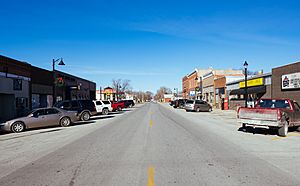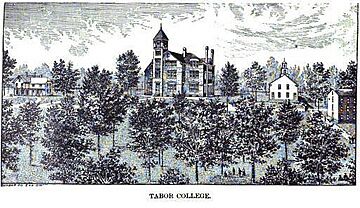Tabor, Iowa facts for kids
Quick facts for kids
Tabor
|
|
|---|---|
 |
|

Location of Tabor, Iowa
|
|
| Country | |
| State | |
| Counties | Fremont, Mills |
| Area | |
| • Total | 1.29 sq mi (3.35 km2) |
| • Land | 1.29 sq mi (3.35 km2) |
| • Water | 0.00 sq mi (0.00 km2) |
| Elevation | 1,240 ft (380 m) |
| Population
(2020)
|
|
| • Total | 1,014 |
| • Density | 784.83/sq mi (303.08/km2) |
| Time zone | UTC-6 (Central (CST)) |
| • Summer (DST) | UTC-5 (CDT) |
| ZIP code |
51653
|
| Area code(s) | 712 |
| FIPS code | 19-76935 |
| GNIS feature ID | 468776 |
| Website | www.taboriowa.us |
Tabor is a city in Fremont County and extends northward into Mills County in the U.S. state of Iowa. The population was 1014 at the time of the 2020 census.
Contents
Geography
According to the United States Census Bureau, the city has a total area of 1.29 square miles (3.34 km2), all land.
History
In 1852 the city of Tabor was founded by "a few families from Oberlin, Ohio, almost all of them Congregationalists," "generous people, early settlers from New England and Ohio who had brought with them Puritan ideas of religion, and Sumner's and Phillips' and Garrison's ideas of freedom." Among them were the Christian clergymen George Gaston, Samuel A. Adams, and Rev. John Todd, and their families. They chose to settle in what is now Tabor in order to found a Christian college, which eventually became Tabor College. The founders were impressed with this high location and mutually selected the name "Tabor" after the Biblical name of Mount Tabor, a mountain near Nazareth, the town of Jesus' childhood.
The town was the home of many abolitionists; Rev. Todd, co-founder of Tabor College, was a "conductor" on the Underground Railroad. The residents of Tabor held monthly abolitionist prayer meetings, and helped runaway slaves whenever they could.
During the Bleeding Kansas period (1854–1860), Tabor was on a route established to enable anti-slavery partisans to reach Kansas without needing to go through the slave state of Missouri. A shipment of 200 Sharps rifles, sent from Boston for use in Kansas by free-state partisans, were stored there (in John Todd's barn). In 1857–1858 abolitionist John Brown spent the winter in Tabor, assembling and training men for his raid on Harpers Ferry.
Tabor College was located in the city from 1853 until 1927, when it closed for financial reasons. The college's buildings housed German prisoners of war during World War II.
The Tabor & Northern Railway, a 9-mile line connecting with the Wabash Railroad at Malvern, operated from 1889 to 1934. It was operated by the college.
Demographics
| Historical populations | ||
|---|---|---|
| Year | Pop. | ±% |
| 1870 | 310 | — |
| 1880 | 320 | +3.2% |
| 1890 | 503 | +57.2% |
| 1900 | 934 | +85.7% |
| 1910 | 909 | −2.7% |
| 1920 | 1,186 | +30.5% |
| 1930 | 1,017 | −14.2% |
| 1940 | 976 | −4.0% |
| 1950 | 869 | −11.0% |
| 1960 | 909 | +4.6% |
| 1970 | 957 | +5.3% |
| 1980 | 1,088 | +13.7% |
| 1990 | 994 | −8.6% |
| 2000 | 993 | −0.1% |
| 2010 | 1,040 | +4.7% |
| 2020 | 1,014 | −2.5% |
| Source: and Iowa Data Center Source: |
||
2020 census
As of the census of 2020, there were 1,014 people, 386 households, and 271 families residing in the city. The population density was 785.0 inhabitants per square mile (303.1/km2). There were 418 housing units at an average density of 323.6 per square mile (124.9/km2). The racial makeup of the city was 93.5% White, 0.4% Black or African American, 0.0% Native American, 0.3% Asian, 0.3% Pacific Islander, 1.5% from other races and 4.0% from two or more races. Hispanic or Latino persons of any race comprised 2.3% of the population.
Of the 386 households, 35.8% of which had children under the age of 18 living with them, 51.8% were married couples living together, 7.8% were cohabitating couples, 25.4% had a female householder with no spouse or partner present and 15.0% had a male householder with no spouse or partner present. 29.8% of all households were non-families. 24.6% of all households were made up of individuals, 12.4% had someone living alone who was 65 years old or older.
The median age in the city was 41.1 years. 29.3% of the residents were under the age of 20; 3.5% were between the ages of 20 and 24; 21.9% were from 25 and 44; 23.5% were from 45 and 64; and 21.9% were 65 years of age or older. The gender makeup of the city was 47.6% male and 52.4% female.
2010 census
At the 2010 census, there were 1,040 people, 418 households and 272 families living in the city. The population density was 806.2 per square mile (311.3/km2). There were 451 housing units at an average density of 349.6 per square mile (135.0/km2). The racial makeup was 98.5% White, 0.7% African American, 0.3% Asian, 0.1% from other races, and 0.5% from two or more races. Hispanic or Latino of any race were 2.0% of the population.
There were 418 households, of which 29.9% had children under the age of 18 living with them, 50.2% were married couples living together, 10.0% had a female householder with no husband present, 4.8% had a male householder with no wife present, and 34.9% were non-families. 31.6% of all households were made up of individuals, and 15% had someone living alone who was 65 years of age or older. The average household size was 2.34 and the average family size was 2.95.
The median age was 44.3 years. 23.2% of residents were under the age of 18; 6.2% were between the ages of 18 and 24; 21.3% were from 25 to 44; 27.1% were from 45 to 64; and 22.2% were 65 years of age or older. The gender makeup of the city was 48.3% male and 51.7% female.
Education
Fremont–Mills Community School District operates public schools.
National Historic Places and attractions
- Todd House (1853), home of abolitionist John Todd and Underground Railroad station, now a museum
- Hunter School (1901), one room school house
- Tabor Antislavery Historic District (1853), series of abolitionist related buildings and places
See also
 In Spanish: Tabor (Iowa) para niños
In Spanish: Tabor (Iowa) para niños


